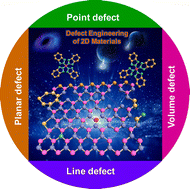Defect engineering of two-dimensional materials for advanced energy conversion and storage
Abstract
In the global trend towards carbon neutrality, sustainable energy conversion and storage technologies are of vital significance to tackle the energy crisis and climate change. However, traditional electrode materials gradually reach their property limits. Two-dimensional (2D) materials featuring large aspect ratios and tunable surface properties exhibit tremendous potential for improving the performance of energy conversion and storage devices. To rationally control the physical and chemical properties for specific applications, defect engineering of 2D materials has been investigated extensively, and is becoming a versatile strategy to promote the electrode reaction kinetics. Simultaneously, exploring the in-depth mechanisms underlying defect action in electrode reactions is crucial to provide profound insight into structure tailoring and property optimization. In this review, we highlight the cutting-edge advances in defect engineering in 2D materials as well as their considerable effects in energy-related applications. Moreover, the confronting challenges and promising directions are discussed for the development of advanced energy conversion and storage systems.



 Please wait while we load your content...
Please wait while we load your content...